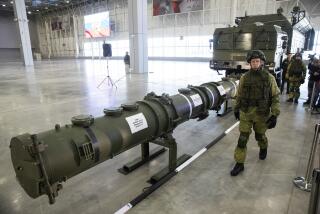Soviet Aide Questions U.S. Missile Stand
MOSCOW — Veteran Soviet arms control negotiator Viktor P. Karpov said Sunday that the United States may be trying to scuttle breakthroughs in medium-range missile talks with demands about short-range nuclear weapons and with other proposals.
“There is increasing evidence that the United States does not really desire the elimination of medium-range missiles in Europe, that the ‘zero option’ was a bluff from the very outset,” Karpov said.
Elimination of medium-range missiles from Europe, the so-called “zero option,” was first proposed by President Reagan in 1981.
Progress toward an agreement was blocked by Soviet-U.S. wrangling over U.S. deployments of medium-range missiles, announcement of the U.S. “Star Wars” research program and other issues.
On Feb. 28, Soviet leader Mikhail S. Gorbachev offered to negotiate an agreement on eliminating U.S. and Soviet medium-range missiles from Europe without linkage to other issues, including “Star Wars”--the Strategic Defense Initiative for a space-based missile defense system.
The North Atlantic Treaty Organization allies welcomed the development but expressed concern over Warsaw Pact superiority in conventional arms and Soviet deployment of short-range nuclear missiles in East Germany and Czechoslovakia. Gorbachev said the issue of short-range missiles could be dealt with after a medium-range pact. The United States has no short-range nuclear missiles in Western Europe.
Karpov, a longtime Soviet disarmament negotiator, in January became head of the Foreign Ministry’s newly created Disarmament Department. His remarks were published Sunday by Izvestia, the Soviet government newspaper.
“The proposal put forward in Geneva by the American delegation foresees the possibility of re-equipping medium-range missiles, in part, Pershing 2 missiles, into missiles of a lesser distance,” he said. “Factually, for this it is only necessary to remove the second stage from the Pershing 2.
“That means that virtually all 108 Pershing 2s would remain in Europe, with the preservation of the installations to service them. Above all, the United States proposes not to destroy the cruise missiles deployed in Europe, but to move them out for deployment on ships and submarines,” he said.
“In other words, Washington obviously would like to preserve all these medium-range weapons, but in another guise.”
‘Scrap of Paper’
If U.S. officials “wish to palm off on us a scrap of paper as a cover for the preservation of the U.S. nuclear missile potential in Europe, we will not agree to that,” Karpov said.
The Soviet proposal on medium-range weapons would require dismantling U.S. weapons deployed in West Germany, Britain, Belgium, the Netherlands and Italy, along with Soviet medium-range weapons targeted on Western Europe, over a five-year period. Each side could keep 100 medium-range missiles--the United States on its territory, the Soviets in Soviet Asia.
A U.S. counterproposal included provisions for on-site verifications. U.S. officials said they were optimistic an agreement could be reached soon after the issues of verification and short-range missiles were “nailed down.”
Karpov told a March 12 news conference in London that Moscow is ready to negotiate on short-range nuclear missiles in Europe at the same time it discusses medium-range weapons. But he said the “parallel” talks could not be linked and that the issue of shorter-range weapons should not hamper agreement on medium-range missiles.
There are 316 U.S. and--by Soviet count--243 Soviet mid-range missiles in Europe. The U.S. missiles have single warheads, the Soviet missiles three.
U.S. cruise missiles have a range of about 1,500 miles and Pershing 2s, all deployed in West Germany, 1,080 miles. The Soviet SS-20s have a 3,000-mile range.
Some Western estimates say the Soviets have 650 shorter-range missiles in Europe--SS-12s, SS-22s and SS-23s with ranges of from 300 to 600 miles.
More to Read
Sign up for Essential California
The most important California stories and recommendations in your inbox every morning.
You may occasionally receive promotional content from the Los Angeles Times.










